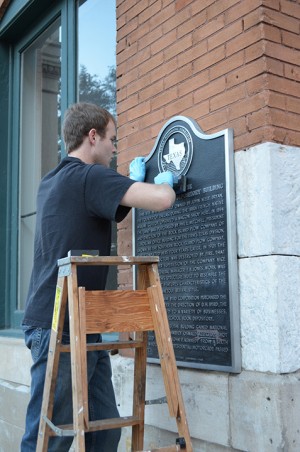
Staff Writer
In preparation for the spotlight that will shine on the city of Dallas where President John F. Kennedy was assassinated 50 years ago, one Baylor student did his part to make sure conspiracy theories would be muted and the day honored appropriately.
Rowlett senior Charles Stokes, apart from his studies as a computer science major, is also the youngest member of the Dallas County Historical Commission and has been since his freshman year at Baylor. Now in his second two-year term as member for the commission, he took it upon himself to restore a defaced historical plaque on the Dallas County Administration Building where Kennedy’s believed assassin, Lee Harvey Oswald, planned and executed his attack on the sixth floor.
“The restoration needed to be done,” Stokes said. “I just thought it was really important that it be in good condition and easy to read, especially with the 50th coming up.”
Stokes said he learned about the sign’s vandalism from an online blog and decided to contact the Director of Planning and Development Rick Loessberg for permission to attempt the restoration. Stokes provided photos of previous restoration work and after review, the young historical commissioner was given the go-ahead to refurbish the plaque.
The main area of concern on the plaque was the last sentence that reads, “On November 22, 1963, the building gained national notoriety when Lee Harvey Oswald allegedly shot and killed president John F. Kennedy from a sixth floor window as the presidential motorcade passed the site.”
Vandals had created a deep gash in the plaque highlighting the word “allegedly.”
Stokes said while he worked on the plaque with his father Judge Charles Stokes who assisted on the Nov. 2 project, several conspiracy theorists approached them and warned they would only return later to repeat their vandalism.
“The guys that sold conspiracy pamphlets told me they were the ones that originally scratched it with a battery powered saw,” Stokes said. “They talked to us while we were out there for a while about possible conspiracy theories involving the CIA Military Industrial Complex. They said that they were the ones responsible for the assassination. I told them ‘I suppose we disagree.’”
Loessberg said he knew after giving Stokes permission to restore the plaque, it would likely be vandalized again and said, because his office is in the building where the plaque rest, he has already seen several lines etched under the word “allegedly” again.
“It’s a misdemeanor but to catch the person doing it is difficult when you have hundred of people walking past it everyday,” Loessberg said. “That’s just a running battle, but we have a black marker to shade that part in. The rest of it looks great though.”
The sign is in much better shape and easy to read for the many viewers that will be in Dallas over the weekend for the event “The 50th: Honoring the Memory of President John F. Kennedy,” which will take place at Dealey Plaza Friday. Stokes is among those who will attend as a VIP guest.
Stokes said he would gladly return to repair the plaque if the county requested his services, even though he described the process as pain staking and said it takes at least four hours to complete. For this repair, Stokes paid out of pocket for the paint and tools needed.
“He’s probably one of the most active members that the board has ever seen,” said Dallas Commissioner Mike Cantrell. He is also the commissioner who first appointed Stokes, the youngest member ever, to the historical society.
“He’s brought a lot of new insight and perspective to that committee,” Cantrell said. “We are very impressed with the work this young man has done.”
Because Stokes is not able to repair every sign in the Dallas area, he said he is putting together a workshop in the near future where he will teach other volunteers how to do a similar type of restoration following the method provided by the Texas State Historical Commission.
Though these activities cut into his school time, he said as a fan of history and as a third-generation historical commission member it is something he greatly enjoys and allows him unique opportunities.
One such unique occasion includes seeing first hand death row inmate rooms in the Dallas County Jail, the same jail that housed Lee Harvey Oswald’s murderer Jack Ruby.
Stokes said while there he stumbled upon what he described as a “death row baptismal room,” where inmates where baptized before their execution. It is closed off to the public and not well known about.
This discovery is of great historical importance, Stokes said, because not only were inmates baptized there but they also created many religious murals.
Stokes is currently seeking funding and partners to help the city of Dallas extract the murals from the now-shutdown jail house so this piece of history can be shared with the world, much like the Sixth Floor Museum showcases the day Kennedy died.



